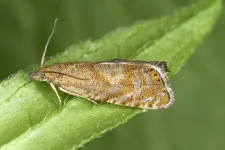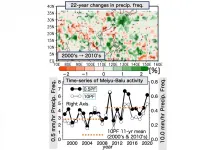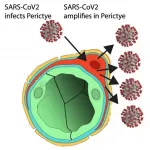(Press-News.org) Butterflies and moths (order Lepidoptera) are one of the most diverse animal groups. To date, scientists have found as many as 5,000 species from the Alps alone. Having been a place of intensive research interest for 250 years, it is considered quite a sensation if a previously unknown species is discovered from the mountain range these days. This was the case when a Swiss-Austrian team of researchers described a new species of alpine moth in the open-access, peer-reviewed journal Alpine Entomology, solving a 180-year-old mystery.
Decades of research work
Initially, the team - Jürg Schmid, a full-time dentist, author and passionate butterfly and moth researcher from Switzerland, and Peter Huemer, head of the natural science collections of the Tyrolean State Museums in Innsbruck and author of more than 400 publications, needed a lot of patience.
Almost thirty years ago, in the 1990s, the two researchers independently discovered the same moth species. While they found it was similar to a moth of the leaf-roller family Tortricidae and commonly named as Dichrorampha montanana which had been known to science since 1843, it was also clearly different. Wing pattern and internal morphology of genitalia structures supported a two-species hypothesis. Moreover, the two were found at the same time in the same places - a further indication that they belong to separate species. Extensive genetic investigations later confirmed this hypothesis, but the journey of presenting a new species to science was far from over.
The Hidden Alpine Moth
To "baptise" a new species and give it its own name, scientists first have to check that it hasn't already been named. This prevents the same species from having two different names, and essentially means looking at descriptions of similar species and comparing the new one against them to prove it is indeed unknown to science. In the case of this new moth, there were six potentially applicable older names that had to be ruled out before it could be named as new.
Intensive and time-consuming research of original specimens in the nature museums of Paris, Berlin, Frankfurt and London eventually led to the finding that all six ancient names actually referred to one and the same species - Dichrorampha alpestrana, which has been known since 1843 and had to be adopted as the valid older name for Dichrorampha montanana as having been described a couple of months earlier. Similarly, all other available names proved to belong to Dichrorampha alpestrana. The species discovered by Schmid and Huemer, however, was different, not yet named, and could finally be described as new to science. The authors chose to name it Dichrorampha velata - the Latin species name means "veiled" or "hidden," pointing to the complicated story behind its discovery.
Lots of unanswered questions
The Hidden Alpine Moth is a striking species with a wingspan of up to 16 mm and a characteristic olive-brown color of the forewings with silvery lines. It belongs to a group of mainly diurnal moths and is particularly common locally in colorful mountain flower meadows. For now, we know that its distribution extends at least from Salzburg and Tyrol through southern Switzerland and the Jura to the French and Italian Alps, with isolated finds known from the Black Forest in Germany, but the researchers believe it might have a wider range in Central Europe.
The biology of the new species is completely unknown, but Huemer and Schmid speculate that its caterpillars may live in the rhizome of yarrow or chrysanthemums like other species of the same genus. As with many other alpine moths, there is a strong need for further research, so we can get a better understanding of this fascinating insect.
INFORMATION:
Original source:
Schmid J, Huemer P (2021) Unraveling a complex problem: Dichrorampha velata sp. nov., a new species from the Alps hitherto confounded with D. alpestrana ([Zeller], 1843) sp. rev. = D. montanana (Duponchel, 1843) syn. nov. (Lepidoptera, Tortricidae). Alpine Entomology 5: 37-54. https://doi.org/10.3897/alpento.5.67498
Researchers are using computer models to simulate COVID-19 infections on a cellular level - the basic structural level of the human body.
The models allow for virtual trials of drugs and vaccines, opening the possibility of pre-assessment for drug and vaccine efficacy against the virus.
The research team at the University of Waterloo includes Anita Layton, professor of applied mathematics and Canada 150 Research Chair in mathematical biology and medicine, and Mehrshad Sadria, an applied mathematics PhD student.
The team uses "in silico" experiments to replicate how the human immune system deals with the COVID-19 virus. In silico refers to trials situated in the silicon of computer chips, as opposed to "in ...
PULLMAN, Wash. --Students who identify as LGBTQ+ in Washington state school districts with conservative voting records reported experiencing more bullying than their peers in more politically liberal areas, according to a new study.
For the study in the journal Analyses of Social Issues and Public Policy, researchers explored the relationships among school district voting records in the 2016 presidential election, bullying experiences in schools and mental health outcomes of LGBTQ+ youth in the state.
The study shows LGBTQ+ students are at a higher risk for psychological distress and suicidality as a result of bullying, particularly in school districts that voted for former ...
WHAT:
In a perspective published in Neuropsychopharmacology, leaders from the National Institutes of Health address how using appropriate language to describe mental illness and addiction can help to reduce stigma and improve how people with these conditions are treated in health care settings and throughout society. The authors define stigma as negative attitudes toward people that are based on certain distinguishing characteristics. More than a decade of research has shown that stigma contributes significantly to negative health outcomes and can pose a barrier to seeking treatment for mental ...
New models of neutron stars show that their tallest mountains may be only fractions of millimetres high, due to the huge gravity on the ultra-dense objects. The research is presented today at the National Astronomy Meeting 2021.
Neutron stars are some of the densest objects in the Universe: they weigh about as much as the Sun, yet measure only around 10km across, similar in size to a large city.
Because of their compactness, neutron stars have an enormous gravitational pull around a billion times stronger than the Earth. This squashes every feature on the ...
Tokyo, Japan - Researchers from Tokyo Metropolitan University have analyzed long-term precipitation radar data from satellites and found significantly enhanced rainfall over the most recent decade during the annual Meiyu-Baiu rainy season in East Asia. The data spans 23 years and gives unprecedented insight into how rainfall patterns have changed. They showed that the increased rainfall was driven by the decadal increased transport of moisture from the tropics and frequent occurrence of the upper tropospheric trough over the front.
From the second ...
Highlights
The results of a new study support the validity of a score that considers various patient-reported outcome measures and preferences for assessing health-related quality of life in individuals with kidney failure.
The score is calculated from assessments of cognitive function, depression, fatigue, pain interference, physical functioning, sleep disturbance, and ability to participate in social roles.
Washington, DC (July 16, 2021) -- Results from a new study support the validity of a score that considers various patient-reported measures and preferences for assessing health-related quality of life and promoting patient-centered care in individuals with kidney failure. The study appears in an upcoming issue of CJASN.
The ...
Highlights
The sodium-glucose co-transporter 2 inhibitor dapagliflozin reduced kidney, cardiovascular, and mortality risks in patients with advanced chronic kidney disease, similar to benefits seen in individuals with normal or moderately impaired kidney function.
Rates of serious side effects were similar in patients with advanced chronic kidney disease who received dapagliflozin or placebo.
Washington, DC (July 16, 2021) -- Studies have shown that diabetes drugs called sodium-glucose co-transporter 2 (SGLT2) inhibitors can provide kidney- and cardiovascular-related ...
Researchers at University of California San Diego School of Medicine and Rady Children's Institute for Genomic Medicine have produced a stem cell model that demonstrates a potential route of entry of SARS-CoV-2, the virus that causes COVID-19, into the human brain.
The findings are published in the July 9, 2021 online issue of Nature Medicine.
"Clinical and epidemiological observations suggest that the brain can become involved in SARS-CoV-2 infection," said senior author Joseph Gleeson, MD, Rady Professor of Neuroscience at UC San Diego School of Medicine and ...
PITTSBURGH, July 16, 2021 - For the first time ever, researchers from the University of Pittsburgh School of Medicine discovered that phages--tiny viruses that attack bacteria--are key to initiating rapid bacterial evolution leading to the emergence of treatment-resistant "superbugs." The findings were published today in Science Advances.
The researchers showed that, contrary to a dominant theory in the field of evolutionary microbiology, the process of adaptation and diversification in bacterial colonies doesn't start from a homogenous clonal population. They were shocked to discover that the cause of much of the early adaptation wasn't random ...
Researchers at UC San Francisco are zeroing in on how the immune system may play a role in miscarriage, which affects about a quarter of pregnancies.
Working in mice, the researchers have found that a recently discovered subset of cells in the immune system may prevent the mother's immune system from attacking the placenta and fetus. If the research is confirmed in further animal studies, and the cells play a similar role in people, they could point the way toward new therapies for pregnancies that are threatened by defects in immune tolerance.
The researchers showed that pregnant mice who did not have this subset of cells, known as extrathymic Aire-expressing cells, were twice as likely to miscarry, and in many ...




